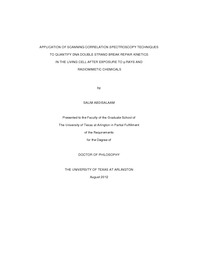
ATTENTION: The works hosted here are being migrated to a new repository that will consolidate resources, improve discoverability, and better show UTA's research impact on the global community. We will update authors as the migration progresses. Please see MavMatrix for more information.
Show simple item record
| dc.contributor.author | Abdisalaam, Salim | en_US |
| dc.date.accessioned | 2013-03-20T19:11:52Z | |
| dc.date.available | 2013-03-20T19:11:52Z | |
| dc.date.issued | 2013-03-20 | |
| dc.date.submitted | January 2012 | en_US |
| dc.identifier.other | DISS-11840 | en_US |
| dc.identifier.uri | http://hdl.handle.net/10106/11566 | |
| dc.description.abstract | The kinetics of most proteins involved in DNA damage sensing, signaling and repair following ionizing radiation exposure cannot be quantified by current live cell fluorescence microscopy methods. This is because most of these proteins, with only few notable exceptions, do not attach in large numbers at DNA damage sites to form easily detectable foci in microscopy images. As a result a high fluorescence background from freely moving and immobile fluorescent proteins in the nucleus masks the aggregation of proteins at sparse DNA damage sites. Currently, the kinetics of these repair proteins are studied by laser-induced damage and Fluorescence Recovery After Photobleaching (FRAP) that rely on the detectability of high fluorescence intensity spots of clustered DNA damage. However, the traditional laser-induced hot-spot accumulation and FRAP methods are not applicable for studying the repair of sparse damage created by ã-irradiation or radiomimetic chemicals, which are more relevant agents of cancer treatment than laser-induced clustered damage. Firstly, the use of Fluorescence Correlation Spectroscopy (FCS), a long-standing technique for quantifying the concentration, diffusion coefficient and the binding kinetics of fluorescently tagged proteins was considered for its usability to address the challenge of quantifying sparse damage kinetics. As part of this effort, initial work focused on establishing FCS capability on test systems with spatial uniformity of protein kinetics as these were known to be amenable to analysis by FCS, before this method was applied to the new area of DNA repair kinetics. The test systems chosen were aqueous solutions of purified DNA repair proteins mixed with short double stranded DNA fragments and an endothelial growth factor receptor (EGFR) live cell system in which EGFR translocated from the cell membrane to the nucleus after ã-irradiation. Though application of FCS to these systems proved successful, when FCS was subsequently applied to the quantification of sparse damage repair kinetics in the living cell it was found that this method yielded high variability in the determined concentrations and effective diffusion coefficients of DNA repair proteins in the nucleus, which was attributed to spatial heterogeneity of the bound fraction and to bleaching artifacts resulting from the protracted point illumination that FCS requires. Subsequently, scanning correlation spectroscopy techniques known as Number and Brightness (N&B) and Raster Image Correlation Spectroscopy (RICS) were applied to the sparse damage kinetics problem as these latter methods involved spatial averaging of kinetics over a user-selected area of the cell with reduced photobleaching, which held promise for reducing the variability of results. Two key double strand break repair proteins, namely Ku 70/80 and the DNA-dependent protein kinase catalytic subunit (DNA-PKCS), were employed as specific examples to showcase the feasibility of using N&B and RICS analysis to quantify dose-dependent kinetics for DNA repair proteins after sparse DNA damage was created by exposure to ã-rays and bleomycin, a radiomimetic chemical. The N&B and RICS analysis results of this work indicated that these methods were suitable to use for quantification of the repair kinetics of sparse DNA damage, which was not currently attainable in DNA repair studies to date. Importantly, these methods could be used to quantify the kinetics of other DNA damage sensing, signaling, and repair proteins in the living cell and could thus contribute towards improving our understanding of the mechanisms controlling cancer treatment response. | en_US |
| dc.description.sponsorship | Alexandrakis, George | en_US |
| dc.language.iso | en | en_US |
| dc.publisher | Biomedical Engineering | en_US |
| dc.title | Application Of Scanning Correlation Spectroscopy Techniques To Quantify DNA Double Strand Break Repair Kinetics In The Living Cell After Exposure To γ-rays And Radiomimetic Chemicals | en_US |
| dc.type | Ph.D. | en_US |
| dc.contributor.committeeChair | Alexandrakis, Georgios | en_US |
| dc.degree.department | Biomedical Engineering | en_US |
| dc.degree.discipline | Biomedical Engineering | en_US |
| dc.degree.grantor | University of Texas at Arlington | en_US |
| dc.degree.level | doctoral | en_US |
| dc.degree.name | Ph.D. | en_US |
Files in this item
- Name:
- Abdisalaam_uta_2502D_11840.pdf
- Size:
- 4.462Mb
- Format:
- PDF
This item appears in the following Collection(s)
Show simple item record


